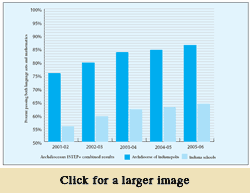2006 Catholic Schools Week Supplement
Students’ ISTEP scores show continued improvement
By John Shaughnessy
 For five straight years, Catholic school students in the archdiocese have shown continued improvement in Indiana’s standardized testing—just one of the trends that excite educators and administrators at the archdiocesan Office of Catholic Education.
For five straight years, Catholic school students in the archdiocese have shown continued improvement in Indiana’s standardized testing—just one of the trends that excite educators and administrators at the archdiocesan Office of Catholic Education.
“The trend lines we want to show are that the longer the students are with us, the better they get,” said G. Joseph Peters, associate executive director of Catholic education for the archdiocese.
Both trends surfaced in the office’s report of the archdiocese’s scores for the 2005-06 ISTEP+ (Indiana Statewide Testing for Educational Progress–Plus).
Since the 2001-02 school year, the percentage of archdiocesan students passing both the math and language arts tests has risen from 75.7 percent to 86.2 percent for this school year. The 86.2 percent compares to the 64.1 percent of all Indiana students passing both tests.
“One of the advantages we have is the continuity we’re able to maintain with our students from the K [kindergarten] through the eighth-grade,” said Ronald Costello, associate executive director of Catholic education and school improvement and director of Project EXCEED. “And we’re able to sustain that at the high school level.”
Costello and Peters credit this success to stressing two key areas: aligning the curriculum to meet the academic standards and providing expanded training for educators.
The increased emphasis began in 2001-02 with a $10 million grant from Lilly Endowment Inc. that was combined with $5 million from other corporate and individual donors.
“We focused on the areas [where] the students needed the most help—writing and problem solving,” Costello said.
Now, the Office of Catholic Education has added another focus: an approach to standardized testing called “Value-Added Assessment.”
Developed by an education researcher in Tennessee, the approach concentrates on measuring not only a student’s proficiency, but also the “growth” of a student’s improvement in test scores from one year to the next.
For the archdiocese, the focus is a combination of achieving “high proficiency” for all students and “high growth” for each individual student.
“We really ought to be looking at each student,” Costello said. “We’ve moved accountability away from the school level to the individual level. You can look good on the average, but not be meeting the needs of the individual student.”
The Office of Catholic Education has already begun to collect information from several schools concerning that approach.
To show the benefits of value-added assessment, Costello shared an article written by Theodore Hershberg, executive director of Operation Public Education at the University of Pennsylvania.
In his article, Hershberg notes that several states—including Arkansas, Minnesota, Colorado and Florida—have passed legislation calling for the introduction of value-added assessment models.
“These states have recognized the many advantages of value-added assessment,” Hershberg writes. “It traces the academic progress of individual students, rather than cohorts; it focuses on ensuring that all students, not simply the lowest performers, receive at least a year’s worth of growth in a year; it provides educators with rich diagnostics to improve instruction.”
Costello stated the goal of the archdiocese’s educational ministry more simply.
“Every student has value,” he said. “We expect them to grow at more than a year’s level each year.” †
